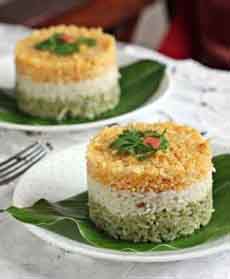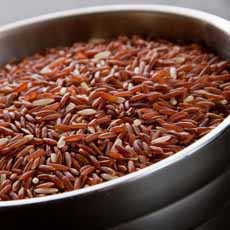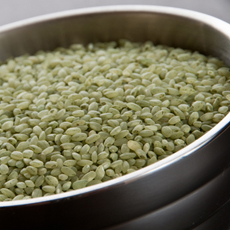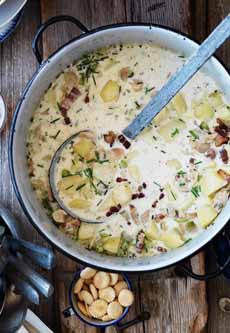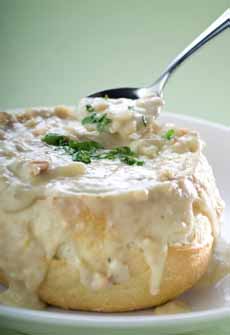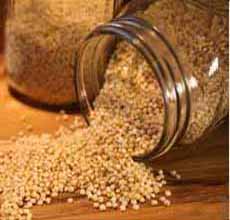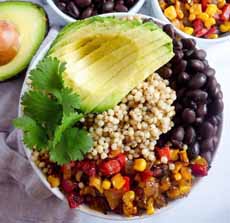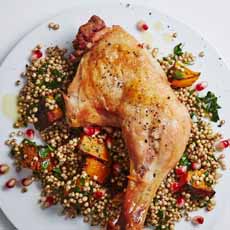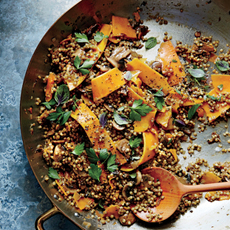
[1] Mushroom and radicchio bread pudding with gruyère cheese (recipe below from Good Eggs/Tartine Bakery).

[2] Chestnut and applewood smoked bacon bread pudding (here’s the recipe from La Brea Bakery).
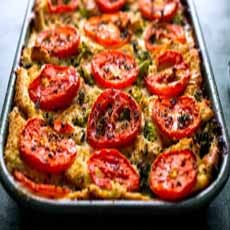
[3] Broccoli, goat cheese, and tomato bread pudding (here’s the recipe from the New York Times).
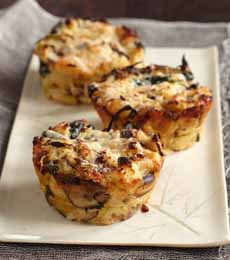 [4] Individual spinach-shiitake bread puddings (here’s the recipe from Food & Wine).
[4] Individual spinach-shiitake bread puddings (here’s the recipe from Food & Wine).

[5] Gruyère (groo-YAIR), which originated in Switzerland, is one of the world’s great cheeses. It is also made across the border in France. Here’s everything you need to know about Gruyère (photo © Castello Cheese).
|
|
Bread pudding is a popular dessert—sweet, custardy, comfort food. It turns no longer fresh bread into something sublime. Leave out the sugar and you have a savory bread pudding, to be served as a side with dinner.
In fact, bread pudding was originally a savory dish, served as a side with dinner (for the poor, it might have been the dinner).
It remains a welcome side dish, but can also replace a frittata, strata, or quiche at brunch.
> Savory Bread Pudding With Mushrooms & Radicchio is below.
> So are more savory bread pudding recipes.
> Plus, different ways to serve savory bread puddings.
> We begin with a brief history of bread pudding.
THE HISTORY OF BREAD PUDDING
Bread pudding originated in the 11th or 12th century as a way to use stale bread.
Pieces of bread were cut or torn, combined with other ingredients (cheese, onions, mushrooms, other vegetables, bits of meat), topped with custard, and then baked until the top was set but the inside was soft and creamy.
Bread pudding is closely related to the Italian dish, strata. The difference is that stratas are typically made with more eggs than cream, making them eggier and more breakfasty—kin to a frittata or a quiche rather than a custard.
The same ingredients can be used with all. The differences are in the proportions, and a strata traditionally uses milk instead of cream.
A soufflé dish or casserole makes the nicest presentation at the table, but you can make bread pudding in a baking pan. Another nice touch is individual servings, made in ramekins, custard cups, or even muffin pans.
If you don’t like mushrooms and radicchio, substitute the same quantity of ingredients you do like; or check out the recipes in the photos or the list below.
TIP: Proteins—chicken, meats, shellfish, smoked fish—are delicious add-ins. Dice or shred leftovers and toss them in.
RECIPE: MUSHROOM & RADICCHIO SAVORY BREAD PUDDING
This recipe hails from San Francisco, courtesy of Tartine Bakery’s Chad Robertson and Good Eggs, the Bay Area’s premium grocery delivery service.
You can assemble the dish a day ahead and refrigerate it, letting it come to room temperature before baking.
Prep time is 25 minutes, and cook time is 50 minutes. Bake the pudding an hour before you plan to serve it.
Ingredients For 4-6 Brunch Servings
1 tablespoon unsalted butter
2 leeks, white parts only, finely chopped
½ cup dry white wine or stock
Olive oil
2 pounds assorted mushrooms, stems trimmed and caps halved
1 head treviso or other radicchio, leaves separated
5 eggs
Pinch salt
1 cup heavy cream
1 cup whole milk
Pinch pepper
Pinch nutmeg
2 teaspoons fresh thyme leaves
2/3 and ½ cup grated Gruyère, divided (substitute Cheddar, Jack, or other semihard* cheese)
3 ounces smoked ham, chopped
2 slices day-old country bread, torn into large chunks
Preparation
1. PREHEAT the oven to 375°F. While the oven heats…
2. MELT the butter in a skillet over medium heat. Add the leeks and sauté until soft, 6 to 8 minutes. Add the wine and cook, stirring occasionally, until most of the wine evaporates—about 5 minutes. Remove from the heat.
3. HEAT a large, heavy-bottomed skillet over high heat. Add enough oil to coat the bottom of the pan. When the oil is smoking, arrange the mushrooms cut-side down in the pan and cook without stirring until they are seared and caramelized, about 1 minute more. Stir the mushrooms; add the radicchio and cook until it is wilted, about 1 minute. Season to taste. Remove from the heat.
________________
*Semihard cheese is a classification based on the weight and texture of the body (paste). They are not hard cheeses, like Aged Gouda, Mimolette, or Parmesan, but yield easily to a knife. Examples include Colby, Comte, Edam, Gouda, Jarlsberg, Manchego, Queso Blanco, and “Swiss.”
|
4. MAKE the custard. Whisk the eggs and salt in a bowl until well blended. Add the cream, milk, pepper, nutmeg, thyme, 2/3 cup cheese, and ham and whisk to combine.
5. PLACE the bread chunks in an 8-inch soufflé dish and add the leeks, mushrooms, and radicchio. Pour in the custard all the way to the rim. Sprinkle evenly with the ½ cup cheese. Let stand for 8 to 10 minutes until the custard saturates the bread.
6. BAKE until the custard is no longer runny in the center, about 50 minutes. Let the pudding rest for 15 minutes before serving.
MORE SAVORY BREAD PUDDING RECIPES
Artichoke Bread Pudding
Butternut Squash Bread Pudding
Chestnuts & Applewood Smoked Bacon Bread Pudding
Cranberry, Pecan & Bacon Bread Pudding
Mushroom, Leek & Parmesan Bread Pudding
Mushroom & Radicchio Bread Pudding (above)
Portabella Bread Pudding
Savory Sausage and Cheddar Bread Pudding
Spinach Bread Pudding With Lemon & Feta
Spinach & Garlic Bread Pudding
Spinach-Shiitake Bread Pudding
WAYS TO SERVE SAVORY BREAD PUDDING
We love bread pudding as a side with dinner: roast chicken, seared salmon, pork chops, etc. It’s a more interesting relative of stuffing/dressing.
But consider these uses:
Breakfast & Brunch: Top warm squares with a soft-poached or fried egg, a drizzle of hollandaise or salsa verde, and a simple arugula salad.
Breakfast-For-Dinner: Serve with crispy bacon or sausage, and a side of tomato chutney or drizzle of hot honey.
Bread Pudding Benedict: Top a thick slice with ham or smoked salmon, a poached egg, and hollandaise sauce.
“Hash”: Cube, pan-fry with onions and peppers until crisp, and serve with eggs any style.
Soup Or Salad, Side Or Crouton: As a side accompaniment with soup or salad, but also as a topper. Cut into jumbo croutons, toast, and float on soups (butternut squash, cream of mushroom, tomato, etc).
“Sandwich”: Slice into thick slabs, griddle both sides, and use as the “bread” for a pressed sandwich or patty melt.
Stuffing: Stuff roasted peppers, tomatoes, or acorn squash halves.
Small Plate: Cut into rectangles (or wedges, if circular), crisp the edges in butter as needed, and plate with a demi-glace and pickled onions and/or gherkins for a small, elegant course.
CHECK OUT WHAT’S HAPPENING ON OUR HOME PAGE, THENIBBLE.COM.
|









